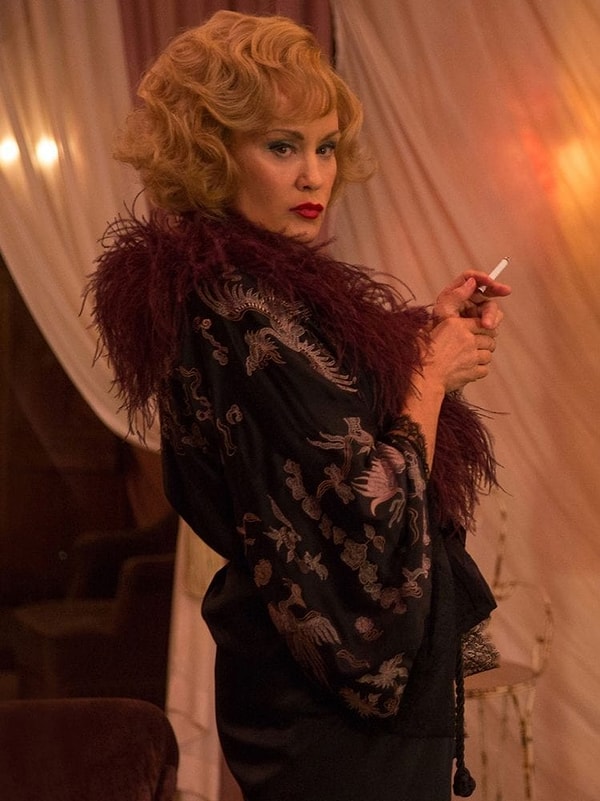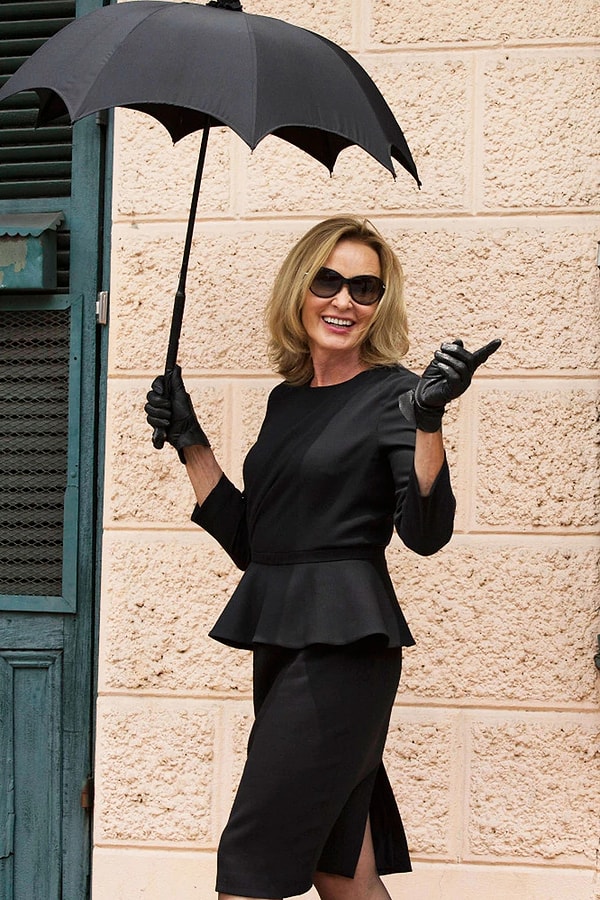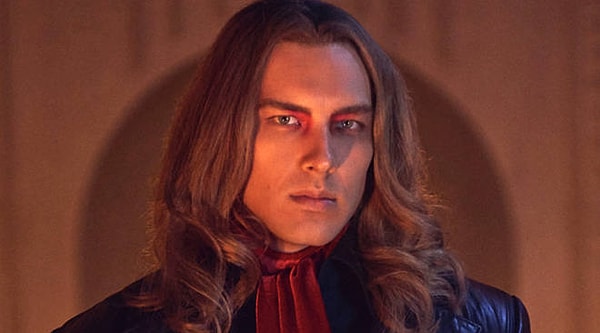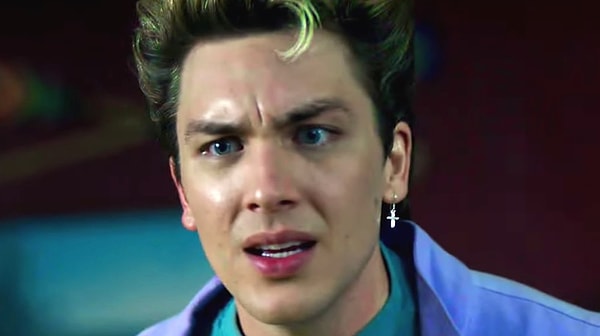American Horror Story Can Recover From Its Drop in Viewership
Like many American Horror Story fans, I remember the moment I realized I was in love with Jessica Lange. She came walking down the hall of a hospital, draped in black and white faux fur, wearing a bright pink dress and a church hat. She was holding a carpet bag with the devil's face embroidered on the front, and her eyebrows had been penciled on with that 1940s surprised look we've all seen in old black-and-white films.
It was exotic, garish, and--oh, so intriguing. I knew she was evil, and I loved it. She stopped at the nurse's station, lit a cigarette, and I melted. It was like Marlene Dietrich had come back to life.
In my eyes, Jessica Lange was the last silver screen diva--the best of them. She could make anyone swoon with her Lucky Strike and that fake German accent. Of course, it wasn't just Elsa Mars that caught my eye--no, there was Sister Jude Martin, Constance Langdon, and Fiona Goode--the many facets of the same Goddess, and every one of them so elegant and so deliciously wicked, I simply could not get enough.
She could kill, maim, and torture--she even planned to sacrifice a baby, and we still rooted for the woman. Why? Because she was Jessica Lange, and she owned that screen. It was hers.
People flocked to get a look at the starlet who could give Bette Davis a run for her money, and the numbers reflected that. According to Decider, the show grew from 1.789 million in the first season to 7.638 at its height during 'Freak Show' in 2014--just four years later. It was an impressive audience.

Courtesy of FX
Rise and Fall
Fans around the world went into mourning when Lange announced that she would not be returning for season 5. Her powerful stage presence set the tone. It was hard for many to imagine the show without her.
Up until then, American Horror Story had been growing larger every season. 'Hotel' and 'Roanoke' dropped to just above 6 million views, roughly a million less than 'Freak Show.'
'Cult' and 'Apocalypse' hovered around 5 million views. '1984' had a little over 3 million views, and 'Double Feature' had just over a million.
Multiple factors can skew viewership statistics. They don't account for pirating and group viewings--like families or couples--and Hulu does not release its numbers. But according to Decider, social media and search engine statistics match this trend, and they tend to be more reliable.

Courtesy of FX
The Magic
The American Horror Story fandom is sharply divided in all things. Each season of the series has a different story, targeted to a different demographic, and they all have their favorites. To some, 'Coven' is the one true masterpiece, and they refuse to hear otherwise. Others say 'Murder House' is the only season worth watching, and everything else is diluted dribble. These aren't considered opinions; they're facts, and fans will fight to the death to defend them. There's no point in arguing.
It's the same with actors. Every fan has their favorites. It's different for everyone, but one thing is certain: Their presence matters. Every year, the entertainment industry would gear up to announce the cast, focusing on who would be there and who wouldn't. They'd churn out article after article, quoting comments from actors about why they wouldn't return.
Lange cannot do an interview without being asked about it, especially after her short cameo as Constance Langdon in 'Apocalypse,' and she flat-out refuses. She misses the old troupe. Without them, she doesn't think it will ever be the same again, and she feels like the show is played out. She doesn't think they can ever top 'Freak Show.'
Evan Peters has been on and off due to a series of breakdowns over the years. He's a method actor, who uses a technique meant to get into the mind of each character he plays. Actors who do this sometimes live as that person. It's known to be a strain on actors' mental health, and he's voiced that many times, confessing that his most recent role as Dahmer was probably one of the hardest things he'd ever had to do.
Sarah Paulson, who has been a near constant in the previous seasons, has said that she feels like people would be tired of seeing her face. She will not be appearing in the upcoming season titled 'AHS: NYC.'
Frances Conroy doesn't seem to have the same reservations, and Kathy Bates seems feel the same way, but neither actress will be seen in the series this year.
We can't track how this has affected viewership--except for Lange's absence, of course--but the spotlight has always been on who was in and who was out. Fans cared about the cast, and that makes sense.
That's because the series is character driven. Each actor would take on a specific persona, built from easily identifiable traits. In 'Coven' for example, each witch had a set of powers and eccentricities. In 'Murder House' each ghost would have a backstory and a set behavioral pattern. In 'Asylum,' patients were identified by their mental illness or lack thereof. They were turned into icons like superheroes or X-Men, given a label that we could remember them by.
'Freak Show' gave us a different kind of icon. Each character had something that made them unique. There was a boy with lobster claws, a bearded woman, a hermaphrodite, and a strong man. We knew them by their features, just like we knew the witches by their powers.
The season went to great lengths to find extraordinary individuals who could stand out. They hired the world's tiniest woman Jyoti Amge, who they taught to pronounce English vowels and consonants. They found a trans athlete known for her height. They sought out individuals with rare conditions, giving them unforgettable costumes and makeup.
There was Meep, a sharp-toothed dwarf who bit the heads off of chickens and wore a giant ball of fur, and Pepper, who had a loveable smile of giant protruding teeth. She was left bald except for a tiny ponytail. The goal was to show us something we couldn't look away from, then feed us unforgettable stories, and it worked.

Courtesy of FX
American Horror Story's signature characterization style was met with masterpiece performances, all based on each character's ups and downs, their moments of triumph and shame.
'Coven' focused on Fiona Goode, an aging witch who was desperate to restore her fading life force. Her daughter, Cordelia, was a kindhearted potion maker who taught at Robichaux Academy, a school for young witches in New Orleans.
Cordelia had a strong moral compass and a love for the girls, so fans connected with her when her husband betrayed her, and she was blinded by a vicious acid attack. It's hard not to imagine the sound of her crackling flesh or her empty eye sockets.
Near the end of the season, after Fiona had attempted everything from drowning a student to sacrificing an infant to keep herself alive, we found her sitting in a chair, decrepit and fading, so wrinkled she looked like a skeleton with flesh melting off of her bones. Viewers could almost feel how weak she was.
We followed these two through every moment of their journey, watching Fiona play out her anguish and desperation, while Cordelia fought to keep her students safe.
They showed us everything--from stake burnings to slit throats--in vivid, memorable detail, focused entirely on each witch's individual path. The series did the same with 'Murder House,' 'Freak Show,' and 'Asylum,' always accompanied by the series' characterization formula.
At its best, American Horror had two traits: labels and an intimate portrayal of each character's journey. This trend matches the numbers. When the show excluded these two elements, viewership dropped.
'Roanoke' split each of the characters into two. There were the actors portraying them and the actual characters themselves.
The actual characters narrated a documentary about the time they spent living in a house in Roanoke, Virginia, while the actors played out a dramatization. It was hard not to identify with the actors because they were the ones experiencing all the of the horror, and the characters seemed bland--boring, almost.
At a certain point, the documentary ended, and the actors that we identified with started acting like their 'real selves.' They turned out to have funny accents, strange attitudes, and ways of being. It completely shattered the connection we thought we had with these people.
When we entered the Roanoke House for a second time, under the pretense of a reality show, everything was different. We were shown that the universe we had connected with was mostly fake, Hollywood magic--detaching us entirely from the storyline. It was like breaking the fourth wall and ruining the mood. It knocked the viewers out of their trance, something writers and filmmakers are constantly working against. Everything is supposed to be based on sucking the reader into the scene, not throwing them out of it. It was an experiment gone wrong.
'Roanoke' characters did not have the usual labels, though they were identified by who they played, or their part in the events that inspired the documentary.
We did get decent character arcs. Each character had a struggle, which we followed throughout the season. Some of them were good. But that didn't matter because they had dispelled the magic by showing us behind the scenes of the documentary, making it difficult to connect with them on their path.
The goal, regardless of how it's accomplished, should be to make us feel the plot. In order to do that, we have to feel something for the characters--love, hate, disgust, envy--anything that will tug at our emotions as the show moves forward. Otherwise, we'll be numb to whatever is going on, and we won't care long enough to watch.

Courtesy of FX
What Went Wrong?
'Apocalypse' was bleak, vicious, and disturbing; it was well written, but its status as a sequel meant that viewers would have to spend time watching 'Coven' in order to fully appreciate the storyline.
It's possible that many of the viewers decided to sit through it or watch 'Coven' first, but the old season is 13 hours long, and all of the most emotional moments in 'Apocalypse' were based on old references and beloved characters. This proved that long-time fans were still watching; many of them had been begging for the witches to return since 'Coven' ended.
'Apocalypse' did make an attempt at characterization. Each actor was given a single, one-sided personality trait, which they mimed over and over again. The series took time playing out dinner scenes and interviews to highlight those traits, but they killed most of the characters off right away. We never got to see their struggles through.
Mallory the witch and Michael Langdon the antichrist were both given a moment in the spotlight. We saw a few scenes from Robichaux Academy and her strange powers, but she had no backstory and we knew very little about who she was. Mostly we focused on Michael, and he was almost impossible to identify with. Sometimes he had an emotionless affect; other times he'd be full-grown and crying like a baby. We couldn't like him, and we didn't want him to win. He was pure evil, and he was there to jumpstart the apocalypse. We were rooting for his enemies.
It was the same with the Satanists, who were all evil in a terrifying sort of way. They were gluttonous, murderous, sycophantic, and often repulsive. We didn't want them to succeed, and there was nothing extraordinary about them that made us love them.
The season mostly relied on old connections left behind from 'Coven.' We saw Francis Conroy as the legendary Myrtle Snow, Cordelia Goode at her finest, Queenie, Marie Laveau, and Madison Montgomery. We saw enough of them to root for them during the final battle, but it wasn't in-depth, not like the intimate portraits we watched during the previous seasons.
The season also made the mistake of using the same actors to play multiple roles. They introduced a new witch played by Joan Collins, who also played a ditzy grandmother. Sarah Paulson played a medium. She also played the witch Cordelia and a middle manager involved with the Illuminati. Evan Peters played a tech CEO and a gay stylist, and the list went on. We'd be introduced to these new characters, and they would either die or be forgotten.
It was neither emotional nor intimate, and we didn't see any other qualities that made the show so popular during its heyday. It is likely that 'Apocalypse' nearly 5 million viewers were there for nostalgia. While it proved that the show was still alive, it did nothing to further the cause.
That could be why '1984' saw such a heavy slump in viewership numbers. Maybe fans decided that 'Apocalypse' was the end, or they decided not to watch the new seasons because they missed the nostalgia. Very few of the show's favorites took part in the season. Evan Peters was gone, and so was Sarah Paulson. Lily Rabe did make a brief appearance, but it was insignificant, and it didn't make use of her famous range.
The season was meant to be an homage to the classic slasher films of the 80s, using tropes that we could identify from the old films, but it also inherited the genre's penchant for killing off the characters right away without giving them the backstory we had seen in so many of the other seasons. They were terrible at tying up loose ends. One character, Xavier, was quite interesting but we never got to see his storyline finish. All in all, everyone was just there--labeled, yes--but very little was explored, robbing the fans of any semblance of a story worth watching.
'1984' is a source of contention for many. There are those who would disagree and say that it represented the best of the series, but we can still take an objective look at the viewership numbers and point to the many qualities it was missing--qualities that the show excelled at when it was at its peak.

Courtesy of FX
Why Double Feature Failed to Bring in Viewers
'American Horror Story: Double Feature' is widely considered to be the show's greatest flop. To many, that is a matter of taste. But it did have the lowest viewership since 'Murder House,' and the storylines were incomplete and disjointed.
It was split between two parts: 'Red Tide' and 'Death Valley.'
'Red Tide' had the intriguing characters it needed to rise above. There was Tuberculosis Karen, the genius watercolorist who lived on the streets, and Frances Conroy's Belle Noir, the sultry novelist who left her husband to become a vampire. We met them. We got a partial picture of who they were, but their stories were brief and dissatisfying.
Tuberculosis Karen is the best example of that. Most of the cast was made up of creatives chasing their muse. They kept coming up against mental blocks, and it made them desperate. A chemist moved to town and started selling pills that would bring out their gifts, but it turned them into vampires.
Nearly everyone gave in and got addicted, but not Karen. She had seen what the pills did to people, and she wasn't going to let herself spill unnecessary blood. Finally, she was given the choice, take a pill or die. She painted her masterpiece on the beach and committed suicide, giving up fame and fortune to save her soul.
It was beautiful, but we knew nothing about her--who she was or where she came from, why she was on the streets--and we spent several episodes wondering before we saw anything.
We had the same issue with Frances Conroy and Evan Peters. We saw these stylish, wicked villains, but unlike most other seasons we never got inside their heads. It didn't make sense considering the part they played in the story. We should've been given something we could take a bite out of.
The minor characters were the type of people that American Horror Story would usually follow up on. They had names and strange traits. Many of them were played by members of the cast we had seen in other seasons.
Sometimes they gave us glimpses of a story the series decided not to pursue. The best example was Billie Lourd, who played a shopkeeper that sanded down vampires' teeth into fangs. We received an introduction. We saw a bit of her personality, and then she was gone. Normally we would've been given more. There was also a member of law enforcement who threatened to find out what was going on around town. She showed up at the city council, made a speech, then disappeared without a follow-up.
'Red Tide' had potential and even depth. It was an allegory for amphetamine use in the creative world. It's possible to do a deep dive into that symbolism. But the story was lacking.
'Death Valley' was even worse. Every single episode was a mess of deadends, introducing characters like Richard Nixon and Amelia Earhardt, like quick teases, only to abandon them a few short minutes later. We didn't get to know anyone. There were long portions of the story that had been cut out. The concepts were wildly intriguing. The invasion, possession, and even their use of Mamie Eisenhower were enough to make us beg for more, but it was all over before it started.

Courtesy of FX
Things Can Be Turned Around
Something did go wrong with 'Double Feature.' The season was delayed a year, and according to Variety, they were forced to shut down production due to a positive COVID test. It looks like they cleared out, salvaged everything they could from 'Red Tide,' and tacked on a few sloppy episodes of 'Death Valley' to fill up the last slots in the season.
Had they been allowed to complete production, 'Red Tide' probably would have had all of the components we love. They labeled the characters based on their specific talents and memorable traits. They had some of their backstories filled in. Just a bit more face time and it could've worked. It might have even made up for '1984.'
Personally, I think the series knows what we want. They've been doing trial and error for more than a decade. They've had more than enough time to study their fanbase, what works, and what doesn't. We can see them trying to correct their mistakes, responding to the fans' wants and needs. They're listening. People begged them to bring back the witches in 'Coven,' and they did. They often address common fan concerns directly in interviews.
They've moved heaven and earth to bring in the cast members we want. They've added easter eggs pointing to our favorite moments in previous seasons, and they continue to try to find new ways to get into each character's head.
The magic is there. The formula is well-known. They know their mistakes because the numbers clearly reflect them. There's no reason why they can't deliver, and they probably would have done so earlier with season 10 had their production not been forced to shut down.
American Horror Story won't have that problem with 'NYC.' Filming has been allowed to go on uninterrupted, and while the season is missing many of the actors we love, it's filled with tried and true veterans, some of whom have been proving themselves onscreen for more than 30 years.
There's a level of quiet optimism in the fanbase. They've been following the show since it premiered, and they know it still has potential. They're just waiting to see what happens. Fans won't have to wait long. The first two episodes of 'AHS: NYC' will air October 19 on Hulu and FX.
American Horror Story: NYC | S11 Teaser - Something's Coming | FX
Keşfet ile ziyaret ettiğin tüm kategorileri tek akışta gör!

Send Comment